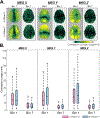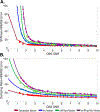Correlated noise in brain magnetic resonance elastography
- PMID: 34687069
- PMCID: PMC8776601
- DOI: 10.1002/mrm.29050
Correlated noise in brain magnetic resonance elastography
Abstract
Purpose: Magnetic resonance elastography (MRE) uses phase-contrast MRI to generate mechanical property maps of the in vivo brain through imaging of tissue deformation from induced mechanical vibration. The mechanical property estimation process in MRE can be susceptible to noise from physiological and mechanical sources encoded in the phase, which is expected to be highly correlated. This correlated noise has yet to be characterized in brain MRE, and its effects on mechanical property estimates computed using inversion algorithms are undetermined.
Methods: To characterize the effects of signal noise in MRE, we conducted 3 experiments quantifying (1) physiomechanical sources of signal noise, (2) physiological noise because of cardiac-induced movement, and (3) impact of correlated noise on mechanical property estimates. We use a correlation length metric to estimate the extent that correlated signal persists in MRE images and demonstrate the effect of correlated noise on property estimates through simulations.
Results: We found that both physiological noise and vibration noise were greater than image noise and were spatially correlated across all subjects. Added physiological and vibration noise to simulated data resulted in property maps with higher error than equivalent levels of Gaussian noise.
Conclusion: Our work provides the foundation to understand contributors to brain MRE data quality and provides recommendations for future work to correct for signal noise in MRE.
Keywords: brain; magnetic resonance elastography; physiological noise; pulsation; viscoelasticity.
© 2021 International Society for Magnetic Resonance in Medicine.
Figures








References
-
- Sack I, Jöhrens K, Wuerfel J, Braun J. Structure-sensitive elastography: on the viscoelastic powerlaw behavior of in vivo human tissue in health and disease. Soft Matter 2013;9:5672–5680 doi: 10.1039/c3sm50552a. - DOI
Publication types
MeSH terms
Grants and funding
LinkOut - more resources
Full Text Sources

